Papers by Cynthia Ferrell

Background: The Pediatric Nutrition Series (PNS) consists of ten online, interactive modules and ... more Background: The Pediatric Nutrition Series (PNS) consists of ten online, interactive modules and supplementary educational materials that have utilized web-based multimedia technologies to offer nutrition education for pediatric trainees and practicing physicians. The purpose of the study was to evaluate pediatric trainees’ engagement, knowledge acquisition, and satisfaction with nutrition modules delivered online in interactive and non-interactive formats. Methods: From December 2010 through August 2011, pediatric trainees from seventy-three (73) different U.S. programs completed online nutrition modules designed to develop residents ’ knowledge of counseling around and management of nutritional issues in children. Data were analyzed using SPSS version 19. Both descriptive and inferential statistics were used in comparing interactive versus non-interactive modules. Pretest/posttest and module evaluations measured knowledge acquisition and satisfaction. Results: Three hundred and tw...
From the American Academy of Pediatrics Community Pediatrics Training Initiative (Drs Hoffman, Do... more From the American Academy of Pediatrics Community Pediatrics Training Initiative (Drs Hoffman, Donnelly, and Kaczorowski), Elk Grove Village, Ill; Department of Pediatrics, Oregon Health and Science University (Drs Hoffman and Ferrell), Portland; Department of Pediatrics, University of Illinois at Chicago (Dr Barnes); Department of Pediatrics, University of Rochester Medical Center (Drs Gellin and Kaczorowski), NY; and Children’s National Health System, Department of General and Community Pediatrics (Dr Lichtenstein), Washington, DC Conflicts of interest: none. Address correspondence to Benjamin D. Hoffman, MD, Department of Pediatrics, Oregon Health and Science University, 707 SWGaines St, CDRCP, Portland, OR 97239 (e-mail: hoffmanb@ohsu.edu).

Unresolved Safety Issue (USI) A-48 arose as a result of the large amount of hydrogen generated an... more Unresolved Safety Issue (USI) A-48 arose as a result of the large amount of hydrogen generated and burned within containment during the Three Mile Island accident. This issue covers hydrogen control measures for recoverable degraded-core accidents for all boiling-water reactors (BWRs) and those pressurized-water reactors (PWRs) with ice-condenser containments. The Commission and the nuclear industry have sponsored extensive research in this area, which has led to significant revision of the Commission's hydrogen control regulations, given in Title 10, Code of Federal Regulations, Part 50 (10 CFR 50), Section 50.44. BWRs having Mark I and II containments are presently required to operate with inerted containment atmospheres that effectively prevent hydrogen combustion. BWRs with Mark III containments and PWRs with ice-condenser containments are now required to be equipped with hydrogen control systems to protect containment integrity and safety systems inside containment. Industry has chosen to use hydrogen igniter systems to burn hydrogen produced in a controlled fashion to prevent damage. An independent review by a Committee of the National Research Council concluded that, for most accident scenarios, current regulatory requirements make it highly unlikely that hydrogen detonation would be the cause of containment failure. On the basis of the extensive research effort conducted and current regulatory requirements, including their implementation, the staff concludes that no new regulatory guidance on hydrogen control for recoverable degraded-core accidents for these types of plants is necessary and that USI A-48 is resolved.
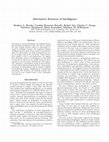
We present a novel methodology for building humanlike artificially intelligent systems. We take a... more We present a novel methodology for building humanlike artificially intelligent systems. We take as a model the only existing systems which are universally accepted as intelligent: humans. We emphasize building intelligent systems which are not masters of a single domain, but, like humans, are adept at performing a variety of complex tasks in the real world. Using evidence from cognitive science and neuroscience, we suggest four alternative essences of intelligence to those held by classical AI. These are the parallel themes of development, social interaction, embodiment, and integration. Following a methodology based on these themes, we have built a physical humanoid robot. In this paper we present our methodology and the insights it affords for facilitating learning, simplifying the computation underlying rich behavior, and building systems that can scale to more complex tasks in more challenging environments.
Academic Pediatrics, 2016
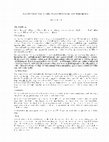
To develop a self calibration ability so that active vision systems can automatically be register... more To develop a self calibration ability so that active vision systems can automatically be registered with other sensory modalities and with motor systems in task space. Motivation: A recurrent problem in using vision to carry out some physical task in the world (e.g., visual navigation, vision guided manipulation, etc.) is to correlate things in visual coordinates with things in other coordinate systems. Some relate to merging information from di erent visual maps, e.g., relating foveal to peripheral representations, some concern merging information from di erent sensory and motor modalities, e.g., relating visual and audio coordinate systems, or visual coordinates and joint motor coordinates for visually guided manipulation, and others use topographic maps to learn better behavior, e.g., saccades, or orientation to moving and noisy stimuli. One way to tackle this problem is to try to have detailed models of sensors, lens non-linearities, actuators, kinematics, etc., and build accurate forward models. This requires extensive calibration phases to measure the properties of the systems. Furthermore, if something changes, either through wear, or by being knocked out of alignment, then everything needs to be recalibrated. A better approach is to use continuous online self calibration, where the forward model need not acutally ever to be explicitly represented. By using principles derived from neuroscience we hope to build systems which continuously update their registrations within and between modalities.
Proceedings of 1993 IEEE/RSJ International Conference on Intelligent Robots and Systems (IROS '93)
The author presents important issues in designing fault tolerant systems for autonomous robots. T... more The author presents important issues in designing fault tolerant systems for autonomous robots. The author also presents the fault tolerance capabilities implemented on the autonomous robot. To tolerate hardware failures, a set of fault tolerance processes are written for each component. These processes are responsible for detecting faults in their respective component, and minimizing the impact of the failure on
Proceedings of PerAc '94. From Perception to Action
This paper explores the viability of using cooperation among local controllers to achieve coheren... more This paper explores the viability of using cooperation among local controllers to achieve coherent global behavior. Our approach is to decompose a difficult control last for a complex robot into a multitude of simpler control tasks for robotic subsystems. We illustrate and examine the effectiveness of this approach via rough terrain locomotion using an autonomous hexapod robot. Traversing rough terrain

Cases on Educational Technology Implementation for Facilitating Learning
Medical resident education changed dramatically on July 1, 2011 with the institution of new duty-... more Medical resident education changed dramatically on July 1, 2011 with the institution of new duty-hour work restrictions. The move to shift scheduling changed the notion of nighttime work from a time of service to one of education. The National Pediatric Nighttime Education Steering Group responded to this paradigm shift by creating a national, peer-reviewed, Web- and case-based curriculum for nighttime learning in pediatrics. Field-test results from implementation in 89 programs revealed statistically significant improvements in knowledge and confidence, but a need for improvement in usability interface, instructional design, and dissemination. Finding support to improve upon the design of the curriculum and provide a robust platform for dissemination and use by residency programs presents a significant challenge, especially in light of severe threats to graduate medical education funding at the national level.
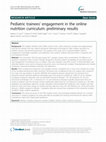
BMC Medical Education, 2014
Background: The Pediatric Nutrition Series (PNS) consists of ten online, interactive modules and ... more Background: The Pediatric Nutrition Series (PNS) consists of ten online, interactive modules and supplementary educational materials that have utilized web-based multimedia technologies to offer nutrition education for pediatric trainees and practicing physicians. The purpose of the study was to evaluate pediatric trainees' engagement, knowledge acquisition, and satisfaction with nutrition modules delivered online in interactive and non-interactive formats. Methods: From December 2010 through August 2011, pediatric trainees from seventy-three (73) different U.S. programs completed online nutrition modules designed to develop residents' knowledge of counseling around and management of nutritional issues in children. Data were analyzed using SPSS version 19. Both descriptive and inferential statistics were used in comparing interactive versus non-interactive modules. Pretest/posttest and module evaluations measured knowledge acquisition and satisfaction. Results: Three hundred and twenty-two (322) pediatric trainees completed one or more of six modules for a total of four hundred and forty-two (442) accessions. All trainees who completed at least one module were included in the study. Two-way analyses of variance (ANOVA) with repeated measures (pre/posttest by interactive/noninteractive format) indicated significant knowledge gains from pretest to posttest (p < 0.002 for all six modules). Comparisons between interactive and non-interactive formats for Module 1 (N = 85 interactive, N = 95 noninteractive) and Module 5 (N = 5 interactive, N = 16 non-interactive) indicated a parallel improvement from the pretest to posttest, with the interactive format significantly higher than the non-interactive modules (p < .05). Both qualitative and quantitative data from module evaluations demonstrated that satisfaction with modules was high. However, there were lower ratings for whether learning objectives were met with Module 6 (p < 0.03) and lecturer rating (p < 0.004) compared to Module 1. Qualitative data also showed that completion of the interactive modules resulted in higher resident satisfaction. Conclusions: This initial assessment of the PNS modules shows that technology-mediated delivery of a nutrition curriculum in residency programs has great potential for providing rich learning environments for trainees while maintaining a high level of participant satisfaction.
We present the results of some early experiments with an autonomous robot to demonstrate its abil... more We present the results of some early experiments with an autonomous robot to demonstrate its ability to regulate the intensity of social inter- action with a human. The mode of social inter- action is that of a caretaker-infant pair where a human acts as the caretaker for the robot. With respect to this type of socially situated learning, the ability to regulate the intensity of the interac- tion is important for promoting and maintaing a suitable learning environment where the learner (infant or robot) is neither overwhelmed nor un- der stimulated. The implementation and early demonstrations of this skill by our robot is the topic of this paper.
... GETTING ORGANIZED FOR SUCCESS: AN INTERACTIVE QUALITATIVE ANALYSIS OF THE DEVELOPMENTAL EDUCA... more ... GETTING ORGANIZED FOR SUCCESS: AN INTERACTIVE QUALITATIVE ANALYSIS OF THE DEVELOPMENTAL EDUCATION PROGRAM AT TYLER JUNIOR COLLEGE Committee: ... EDUCATION PROGRAM AT TYLER JUNIOR COLLEGE by Cynthia Gail Ferrell, BS; M.Ed. ...
Proceedings of Autonomous Agents, 1998
... Consequently, she imparts a consistent meaning to her infant's expressive gestures and e... more ... Consequently, she imparts a consistent meaning to her infant's expressive gestures and expressions, interpret-ing ... The infant does not know the signifi-cance his expressive acts have for his ... motivations should play a significant role in determin-ing the robot's behavior, how it ...
Proceedings of the National Conference on Artificial …, 1998
This paper presents a motivational system for an autonomous robot which is designed to regulate h... more This paper presents a motivational system for an autonomous robot which is designed to regulate human-robot interaction. The mode of social in-teraction is that of a caretaker-infant dyad where a human acts as the caretaker for the robot. An infant's emotions and drives play a very ...
Academic Pediatrics, 2014
Objective-To compare asthma treatment decisions by pediatric residents to current asthma guidelin... more Objective-To compare asthma treatment decisions by pediatric residents to current asthma guidelines and to learn if treatment decisions vary by postgraduate year (PGY) in training. Patients and Methods-We conducted a web-based survey of residents from 10 training programs through the Continuity Research Network of the Academic Pediatric Association (CORNET). Surveys included 6 vignettes of patients on low-dose inhaled steroids with guidelineand non-guideline-based indicators of asthma status and one stable patient on high-intensity medication.
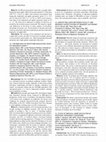
Academic Pediatrics, 2012
RESULTS: 26 different housestaff worked the overnight shifts. During the pilot nights, NICU house... more RESULTS: 26 different housestaff worked the overnight shifts. During the pilot nights, NICU housestaff attended 3.1 fold more (95% C.I.: 2.0-4.0, p<.0001) term newborn resuscitations than during the traditional call nights (geometric mean 2.3 vs. 0.7) and 2.6 fold more (95% C.I.: 1.6-4.0, p<.0001) total resuscitations than in the traditional call nights (geometric mean of 2.9 vs. 1.1). We observed no difference in number of deliveries attended by the newborn nursery housestaff. We found no significant differences in the hours of sleep, number of procedures and burden of patient care. All housestaff in the pilot and traditional q4 call groups reported an appropriate amount of autonomy during the overnight shift. DISCUSSION: The redesign of the traditional call structure to a night shift system can allow for increased overnight exposure to resuscitations and neonatal care, while maintaining housestaff autonomy and a high quality experiential education.
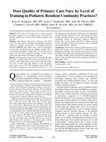
Academic Pediatrics, 2009
Objective.-The aim of this study was to compare parental perception of quality of care provided b... more Objective.-The aim of this study was to compare parental perception of quality of care provided by first-versus third-year pediatric residents who served as their children's primary care providers. Methods.-The Parents' Perception of Primary Care (P3C) survey was administered to all parents who identified a pediatric resident as a primary care provider at 19 Continuity Research Network (CORNET) sites. Parent survey scores were compared between those identifying first-year pediatric residents (PL-1) versus third-year pediatric residents (PL-3) as care providers by using t tests and linear regression modeling, as well as itemspecific chi-square analysis and logistic regression. Results.-Comparing the responses of the 347 parents who identified a PL-3 resident and the 360 parents who identified a PL-1 resident as their child's primary care provider, those who identified a PL-3 resident rated their childrens overall care higher, with a mean score of 79.2 (95% confidence interval [95% CI] 77.5-80.8) as compared to 75.9 (95% CI 74.4-77.3); P < .05. This disparity was primarily due to differences in the longitudinal continuity domain. Comparisons of the other domains of communication, comprehensiveness, access, contextual knowledge, and coordination showed no statistically significant differences between the 2 groups. Parents rated PL-3 residents as having greater knowledge in behavioral counseling and coordination with schools than PL-1 residents. Conclusions.-Parents rated residents at both training levels very highly for the quality of care provided. PL-3 residents had higher longitudinal continuity scores and were perceived to have greater knowledge about behavioral counseling and coordination of care with schools. Further research will need to elucidate strategies to improve earlier resident acquisition of coordination and behavior management skills.











Uploads
Papers by Cynthia Ferrell